There’s a reason why content creation roles are often called “content cooking.” Creating a good piece of content is actually like whipping up an exotic dish that could either go in the trash or become a world-famous recipe like KFC! You should realise though -There is a method to the madness. Here is a basic guide to content marketing for businesses to grow online.
What is Content marketing?
Content marketing is a huge part of the awareness/discovery funnel. The aim of your content should be to win people over to your business or brand.
Check this out to understand the discovery funnel for your customers:
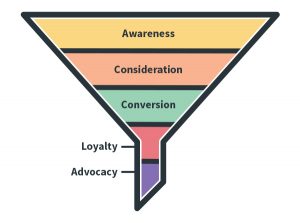
It is a means of marketing or promoting your business in the most creative ways possible so your customers can find you and remember you. The goal is to use content of all kinds to guide potential leads down the funnel and convert them into loyal customers who ultimately become advocates of your brand.
Related read: Word of mouth marketing for online business
What is content?
Think of content like the ingredients to your recipe.
Anything that explains your business to a potential customer is content. Anything you use to educate, inform or communicate with your customer is content.
Made a billboard? That’s content. Posting an ad on Facebook? That’s content. Writing emails? Sending a receipt to a customer? That is content too!
You can post text updates, images, videos, links, and more on social media as social media content. Although almost anything can be made into social media material, that doesn’t mean it should be. Today, we want to convey that message.
Types of content (that sells)
There are several different channels that you can post and promote your content on. What kind of content really sells? Here is a list that you can start off with:
A good, relevant blog
You can start by creating a blog that looks to help your customers understand the industry that you operate in or the product/service you are selling. Having a blog doesn’t just portray you as an industry expert but also helps you promote your business.
Identify what your small business wants to talk about and create valuable blogs that genuinely help solve a problem.
Fantastic emails
Emails are a great way to communicate with your customers (or potentials). Start a newsletter – either curated or your own.
Plan your email campaign by deciding what you want to accomplish. Is it your intention to publicize your business? Are you offering an online course or a blog that people can subscribe to?
Related read: Email marketing: A basic guide on how to start strong
You can communicate product updates, write love letters ( remarketing emails) and even promote a seasonal sale or just drop a note of thanks to your customers. Coupled with a catchy subject line, emails can drive a great amount of traffic to your website.
Take Instamojo’s fortnightly newsletter D2C Wrap for example. It offers relevant and contextual business news to D2C brand owners.
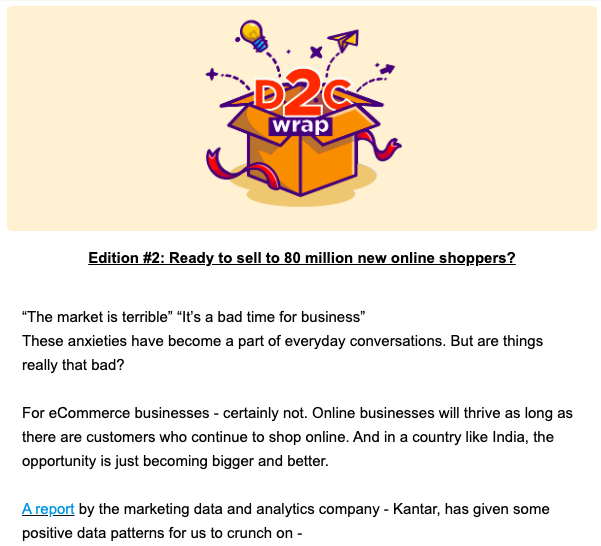
P.S. The Instamojo fortnightly newsletter SME wrap is now D2C wrap!
Short videos & webinars
Of late, videos have gone big! With diminishing attention spans, everyone’s flocking to short explainer videos that do the job without taking too much time.
Making short videos of not just your product but anything relevant to your genre. Live videos or webinars are also a great way to give a demo of your product.
Related read: Host the perfect webinar with this helpful guide
Educational guides
While long-form content may not be at the forefront in the social media-driven world, it creates immense value for a niche audience.
Putting together a video course or a how-to guide also does what a blog can do for your business.
Related read: How to do video marketing for your small business + tools you need to use
A blueprint for successful content marketing
Here is a checklist to get your eCommerce business started with content marketing.
1. Set up an editorial calendar
Most businesses go wrong with their content strategy by not having one! Set up a calendar for the kind of content you want to post and stick to the calendar. This helps you plan what you want to do and how you want to execute your content strategy.
Here are the ways to utilise the best yet free marketing calendars for you to grow your business.
In one of the podcast sessions of Platform For Artists Founder- Pawan Rochwani, Rapti Gupta about how a content calendar has simplified and organized her tasks.
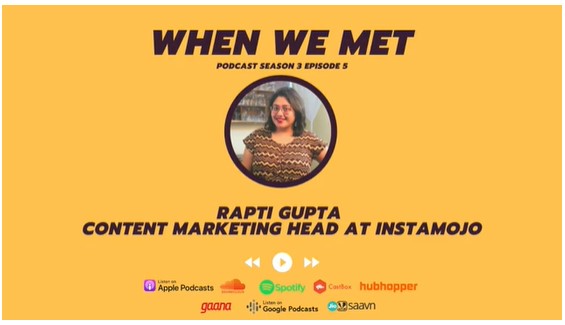
2. Start blogging regularly
A core strategy for basic content marketing is to ensure your blog is consistent. Once you’ve got your domain and have your blog set, keep the content flowing regularly. There is no dearth of topics even if you are a niche business. Recycle old blogs if you’re feeling lazy.
Do not interrupt the flow of posting the blog, as this might get your audience disinterested and affect your business.
It is possible to write even a short blog related to any current and relevant topic and post it on your blog. Let the cyber surfers know that you are active and updating your audience with the latest topics.
You can now easily add blogs to your online store on Instamojo. Letting your customers know more about you and your product knowledge will you with your reputation.
3. Submit your content on social media platforms and forums
By and by as you start building a repository of blogs, start promoting them on social media – Facebook, Twitter, LinkedIn, Quora, etc.
Having a strong social media presence helps establish your brand and makes you more searchable. Bookmark your content on social forums as well.
Related Read: How to set up social media for small business
4. Make other kickass content
Write eBooks, make infographics, and other visual content like videos, gifs, or memes – anything (short form) that has the potential to go viral on social media.
These are the featured books for the month that has attracted many customers due to the content given to all the small business owners.
5. Don’t shun long-form though
White papers, customer success stories, and case studies make for great testimonials and add value to your brand. Go the extra mile to put long-form content together. Write educational content (guides) to educate your customers.
6. Guest blog actively
Offer to write on relevant topics on other popular websites and link back to your own website.
Once you know your audience well, it will be easy for you to write on your own website and also convert customers that are reading your content on other websites!
Guest blogging is a sure-shot way of tapping new customer bases. Here is a guide to starting guest blogging the right way!
7. Check your progress
Set up Google Analytics and keep track of the traffic coming to your website.
Don’t expect to see results immediately. Content marketing may sound simple but it’s trickier than it can seem. Just be consistent and keep writing good-quality content. Your traffic will definitely see an uptick in about a year if you’re consistent.
Did you know you can earn money via a blog? In fact, you can earn money on your blog/website itself just by embedding an Instamojo payment button!
Try a new way of collecting payments today. Try the Instamojo experience!
Set up your side hustle on Instamojo


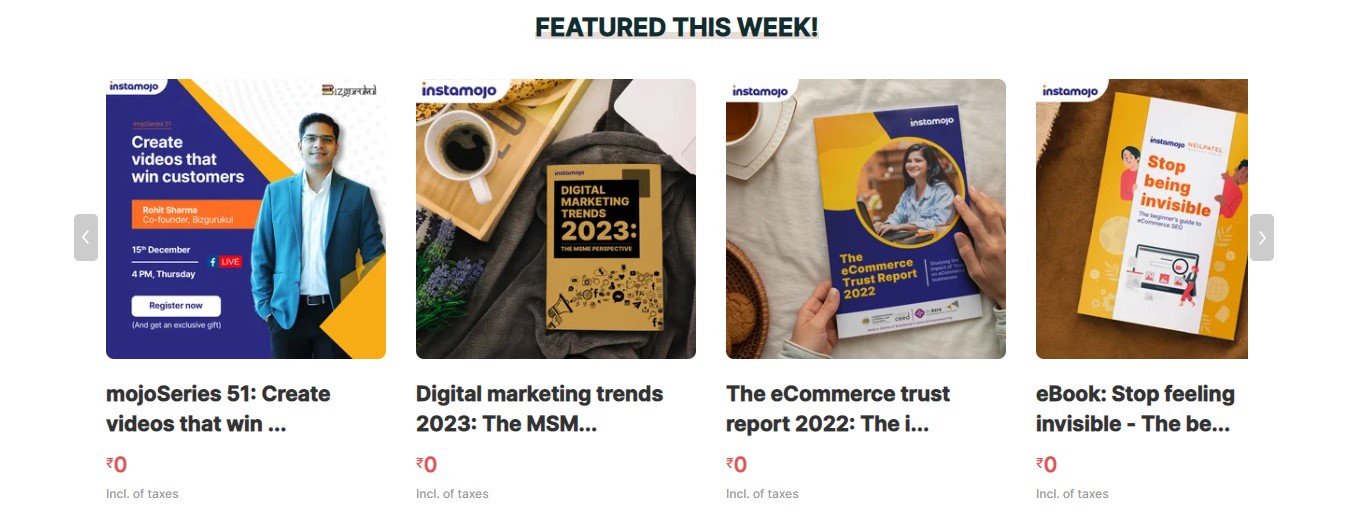
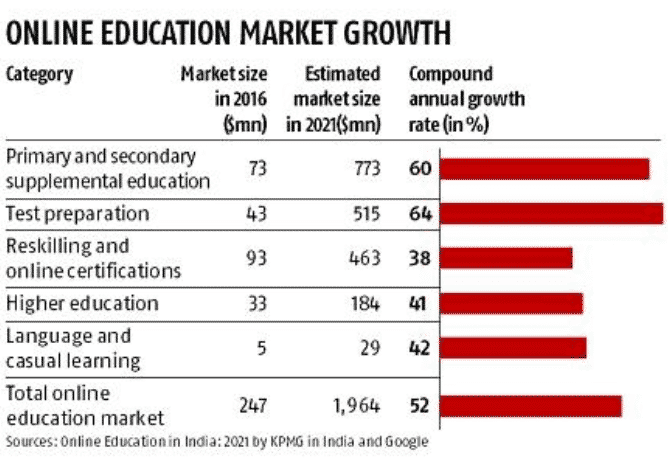
2 comments
I have heard that guest blogging is considered as spam by Google these days. Is it true or just a rumor?
A couple years back, Google noticed a lot of spam coming in via guest blogging. However, Google will never consider legit, fresh and quality content spam. When accepting free content or allowing people to blog on your website, be cautious about the author profile and the kind of content the author is offering. Also, if they can create a bio on your website, nothing like it.